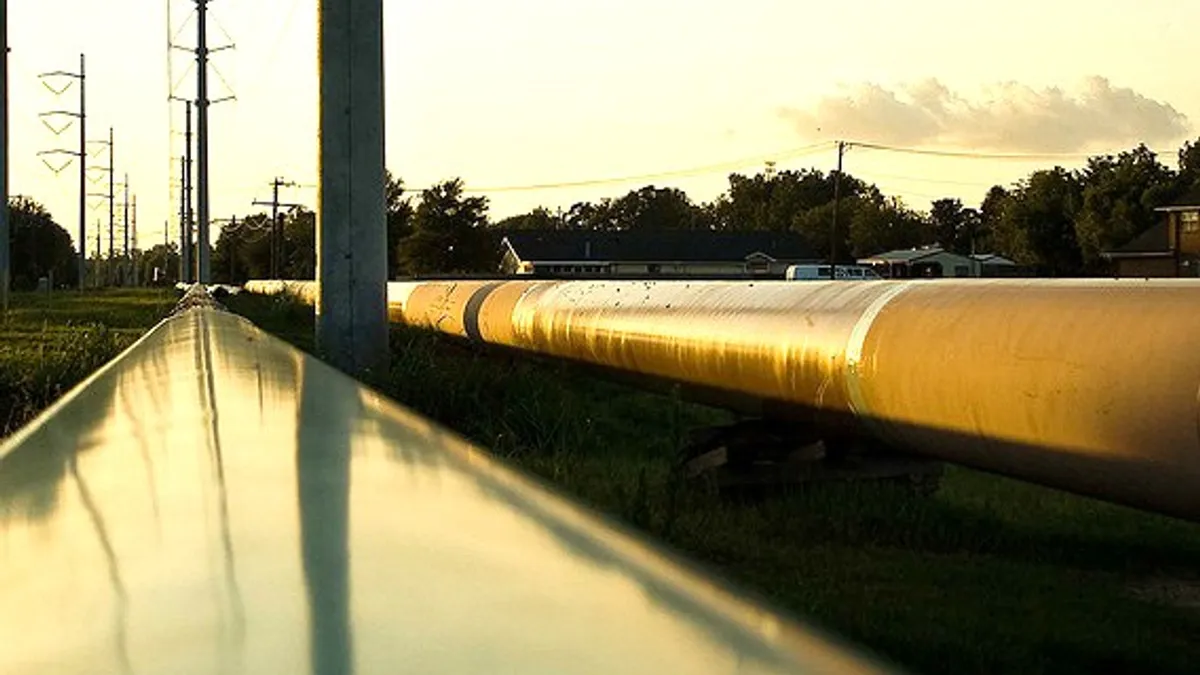Dive Brief:
- The Environmental Protection Agency's (EPA) Office of Federal Activities said natural gas pipeline emissions and the social cost of carbon can be measured with EPA tools, in comments submitted regarding the Federal Energy Regulatory Commission's (FERC) proposal to update its interstate pipeline evaluation process.
- The EPA cited its own tools and the social cost of carbon that FERC could use, even though the Trump administration has adopted a largely anti-climate regulation agenda.
- The EPA said FERC could consider the broader implications of greenhouse gas (GHG) emissions in new natural gas infrastructure mainly through the use of EPA's GHG Inventory and its GHG Reporting Program.
Dive Insight:
As FERC continues to collect input for a proposed revision to its pipeline review process, the commission got an unusual comment last week from the EPA — unusual at least during this administration, as the EPA pursues a roll back of climate and other regulations.
The comment, submitted Thursday by Robert Tomiak, director of EPA's Office of Federal Activities, suggests agency tools that FERC can use to evaluate upstream and downstream emissions from new natural gas pipelines. Tomiak is a career EPA staffer within an office that reviews federal National Environmental Policy Act (NEPA) assessments, part of the larger EPA Office of Policy.
On Friday, Avi Zevin, a lawyer with the Institute for Policy Integrity, flagged the notice on Twitter, noting that an EPA staffer went out of his way to tell another agency that analyses regarding the social cost of GHG emissions are doable. The EPA did not immediately respond to requests for comment regarding the published recommendation.
FERC issued a Notice of Inquiry in April seeking comment on its evaluation of interstate natural gas pipelines, including the environmental impact of projects. Since then, FERC commissioners voted 3-2 to restrict their consideration of climate change impacts in new pipeline environmental assessments. The comment period ends July 25.
EPA's GHG reporting regulation involves a section for methods and factors that specifically calculates emissions for petroleum and natural gas systems, called Subpart W. These tools are not "super easily changeable" if the EPA were to attempt to roll them back, Zevin told Utility Dive, meaning they would continue to be available for FERC's consideration in their pipeline review process.
He also noted that EPA's guidance could lead to estimates that undervalue natural gas pipeline emissions and create overly rosy projections for new projects. Last week, a Science journal report based on existing downwind measurements showed methane leakage at natural gas infrastructure is 60% higher than expected through federal emissions accounting.
The Obama administration's EPA used a global estimate to derive the economic value of the social cost of methane emissions. The EPA comment to FERC does cite a document calculating the social cost of methane, "but one that is limited" to reporting the impacts in the U.S., Zevin said.
The Republican majority at FERC had ruled last month against preparing "upper-bound" estimates of GHG emissions resulting from changes in upstream production and downstream gas consumption for new pipeline capacity. The majority deemed such information "speculative," arguing that it falls outside of the commission’s environmental review obligations under NEPA. The EPA comment suggests that such analyses are at least doable.
Despite the May ruling, FERC Democrat Commissioner Cheryl LaFleur announced in June that she will consider the broader climate impacts of new natural gas infrastructure when voting on new projects. The other FERC Democrat Commissioner, Richard Glick, has written about the agency's failure to address broad climate impacts in each major pipeline decision since his appointment.














